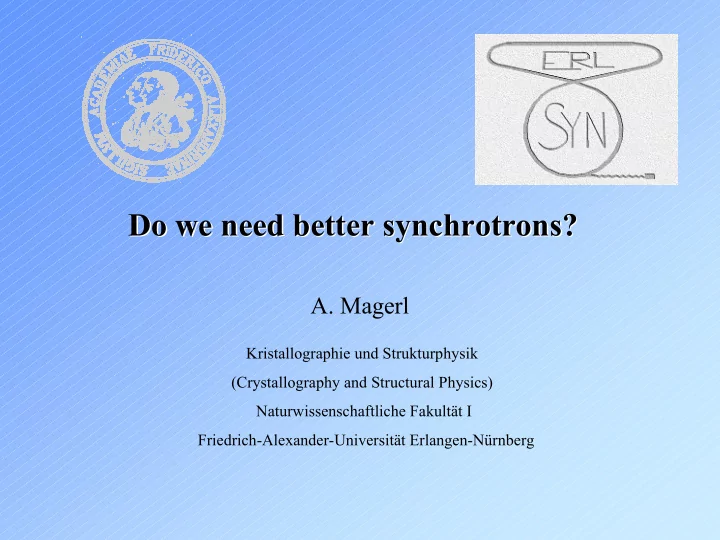

Do we need better synchrotrons we need better synchrotrons? ? Do A. Magerl Kristallographie und Strukturphysik (Crystallography and Structural Physics) Naturwissenschaftliche Fakultät I Friedrich-Alexander-Universität Erlangen-Nürnberg
Overview Overview • today today‘s ‘s synchrotron light sources synchrotron light sources • • a a few examples few examples on on science science • sound-excited crystals shock waves Si 888 in backreflection, an 8-beam case photon storage • the concept the concept of of ERLSYN ERLSYN • stage 1: storage ring stage 2: the ERL upgrade
synchrotron radiation: storage ring insertion devices bending magnet wiggler, undulator • extreme brilliance by small emittance and modern insertion devices (~10 19 photonen s - -1 1 mm mm - -2 2 mrad mrad - -2 2 0.1% 0.1%bandwidth bandwidth) • small source size (anisotropic, horizontal ~100 µ m, vertical ~10 µ m) • partially coherent (0.1 %, phase contrast techniques) • pulsed (length of the electron bunches, 50 ps) • polychromatic (from infra red (cm) to hard x-rays (0,01 Å)) • polarized (linearly or circularly, magnetism)
synchrotron ligth sources synchrotron ligth sources European Synchrotron Radiation Facility ESRF, Grenoble (1994), energy 6 GeV, circumference 844 m SPring8 (1997), Japan Swiss Light Source SLS, Villingen Energy 8 GeV, circumference 1436 m Energy 2,4 GeV, circumference 288 m
Users at the ESRF A SLS is a central facility offering unique experimental conditions for a large number of users from many different fields
The Brilliance of X-ray Sources since their Discovery in 1895 extreme intensity & 1027 quality of the x-ray beam LINAC driven sources 1024 (fourth generation) brilliance: • complex problems 1021 undulator • fast throughput • small samples third generation wiggler 1018 • diluted samples (surfaces) bending • high quality magnet 1012 1015 second generation • high precision • inelastic scattering first generation 109 1012 • magnetism sun 106 109 rotating anode Cray T90 light bulb x-ray tube 103 106 Cray 1 candle ILL FRM II 103 2020 1900 1940 1980 year
The Laue diagram A Laue diagram at SLS number 5 (1912) exposure time 10 -10 s exposure time 30 min
Structure of a membrane protein complex: Formate Dehydrogenase-N at 1.6 Å ( ESRF Highlights 2001) Catalytic α -subunit is shown in orange, ß-subunit in blue and g-subunit in pink. Entries in the Protein Data Bank, Brookhaven, USA, of structures measured with synchrotron radiation W. Minor et al., Structure, 8, R105-R110 (2000)
Michael Cölle, Robert E. Dinnebier and Wolfgang Brütting, High beam quality 2002, Chem. Comm. 23, 2908-2909 precise informationen : structure refinement from powder diagrams Evidence for the facial isomer in the blue luminescent δ -phase of tris(8-hydroxyquinoline)aluminum(III) (Alq 3 ) Isomere in δ -Alq 3 facial meridonal Different degrees of overlap of the π -orbitals of hydroxyquinoline ligands belonging to neighboring Alq 3 molecules are likely to be the origin of the significantly different electro-optical properties. Two isomers in the blue luminescent δ -phase of Alq 3 are possible
synchrotron source laboratory source Crystal structure of δ -Alq 3 in a projection along the c -axis. The two structures can only be distinguished with a resolution as offered on synchrotron beams
a few examples few examples: sound : sound- -excited crystals excited crystals a
The strain field of a sound wave may enlarge a Bragg peak and hence increase the reflected x-ray intensity: tunable optical element. A longitudinal strain field maintains the beam divergence and provides better characteristics than a transversal distorsion (mosaicity). G k f k i A pure longitudinal sound mode?
time dependent rocking curves at 2.35 MHz sound frequency rocking angle [´´] time [ns]
conditions: even harmonic mode of the transducer (5 MHz) wave must have a knot at the ends of crystal
time dependent rocking curves at 8,18 MHz at a crystal resonance rocking angle [´´] time [ns]
time and space dependent rocking curves at 2 MHz at a crystal resonance
The x-ray intensity can be tuned over a wide range by pure longitudinal sound waves
Shock waves waves by by laser laser illumination illumination Shock K. D. Liss et al. laser light causes several processes to occur: thermal shock wave ablation melting and re-crystalisation
geometry and measurement principle: k i single crystal k f laser G Si 111 3 2 rocking curves at half the peak height 10 5 8 compression and dilatation side 7 6 5 4 3 2 intensity 10 4 8 7 6 5 4 1.6E-5 compression 1.6E-5 expansion 3 2 10 3 8 7 6 5 -4 -2 0 2 4 rocking angle [arc. sec.]
compression side expansion side 50 500 0 0 0 -500 -500 -1000 -1000 -1500 -1500 -2000 -2000 -2500 -2500 0 5 10 15 20 0 5 10 15 20 time [µs] time [µs] The propagation velocity of c s = 10066 m/s 40 is higher than the sound velocity for Si c s = ( 10066 ± 54) m/s c r = ( 3390 ± 97) m/s along [111] of c = 9640 m/s. The surface 30 wave has a velocity of c s = 3390 m/s. probe position x [mm] 20 The individual shock wave components are not resolved with 10 present time resolution. 0 2 4 6 8 10 12 14 signal time [µs]
Recommend
More recommend